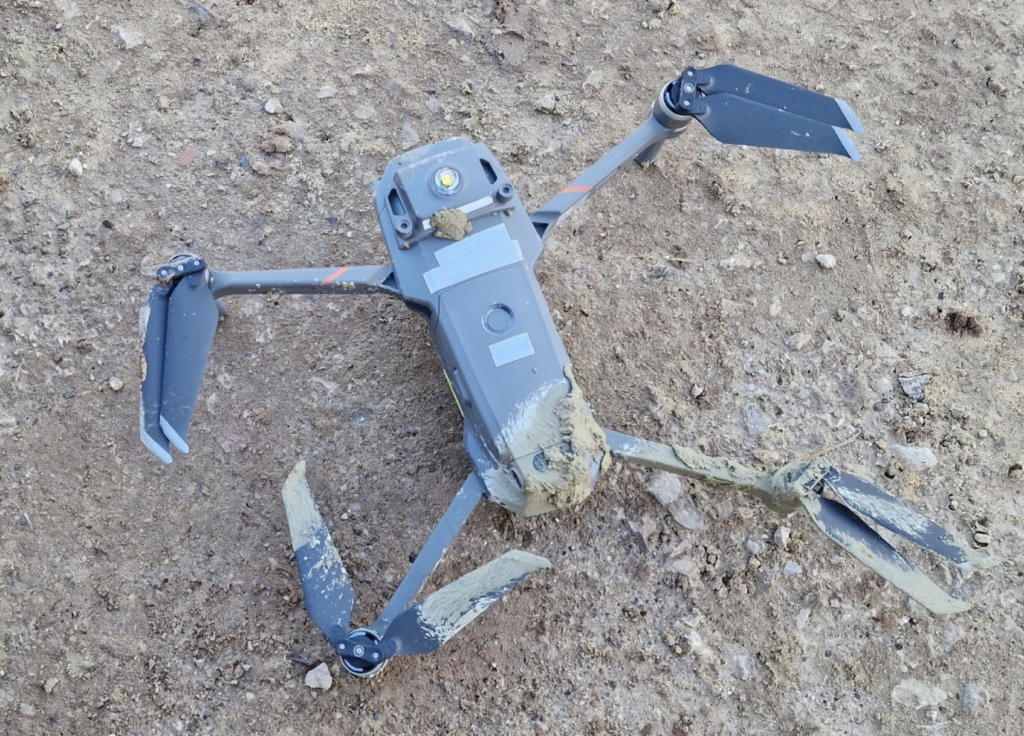The Charity
Aviation
Maritime
DUASxx11
Initial Report
During an aerial survey flight, the UAS detected a rapid loss of battery power and initiated an immediate automatic landing. Whilst descending, its flight behaviour became erratic, control was lost to the remote pilot, and the UA struck an uninvolved person before hitting the ground. The photograph shows the UA after falling to the ground.
It was not possible to determine a cause for the loss of battery power or the flight behaviour. There may have been an opportunity during flight control checks to consider unexpected battery discharge rate as a reason to abort the flight.
The flight was planned in accordance with applicable regulation and guidance for safe distances between the UA and uninvolved people and structures. Due to the erratic flight behaviour of the UA during its automatic landing, coupled with loss of flight control, the UA subsequently breached the required safe distances and then struck the construction worker. The battery was fully charged prior to the flight, was within the manufacturer’s recommended number of cycles, and no defects were found to have affected its chargeDuring flight, the battery percentage detected by the UAS dropped at an unexpectedly high rate that resulted in an automatic landing without notifying the pilot at the pre-set charge thresholds. The first indication of an abnormal battery discharge rate was during flight control checks. The pilot chose to continue with the planned flight as it would have been achievable using the indicated 88% battery level. Subsequently, the UAS continued to detect a high discharge rate which triggered the automatic landing. After the flight the battery integral charge level indicator showed 50-75% charge. It was not possible to determine the difference between this charge level and the battery power displayed on the handheld controller during the flight. Flight log data did not explain the discrepancy in battery level.

The UAS measured a high loss of battery power in a short space of time, leading to an uncontrolled landing where the distance between the UA and uninvolved people and structures was compromised. This sequence of events resulted in the UA striking an uninvolved person. It was not possible to determine a cause of the UA’s detecting a loss of battery power or its flight behaviour. Whilst the displayed level of power remaining was sufficient for the planned flight, there may have been an opportunity during flight control checks for the pilot to consider the abnormal battery discharge rate was likely to continue, and to abort the flight.
CHIRP Comment
Warnings during pre-flight control checks should always be heeded. Not everything is explained in the user manual of these type of aircraft, so a warning that comes up on the controller, which is then countered by other indications, deserves a landing followed by careful consideration. The software sometimes includes in-built triggers that are not fully explained, perhaps because they were part of an update instigated after the manual was published.
Operators are now being encouraged by the Regulator to use any of the publicly available Apps that track a Drone’s maintenance status. This includes the status of the battery and is granular enough to track performance of each battery cell. We highly recommend all pilots pre-flight check the performance of their aircraft’s batteries on previous flights as a way of detecting any potential weakness in battery performance that may impact their planned flight. It is human nature to forge on if the pilot is under time pressure and thinks they can achieve the task with a reasonable margin of “fuel”. It is easy under such circumstances to ignore a warning indication, but it is a mistake to do so!